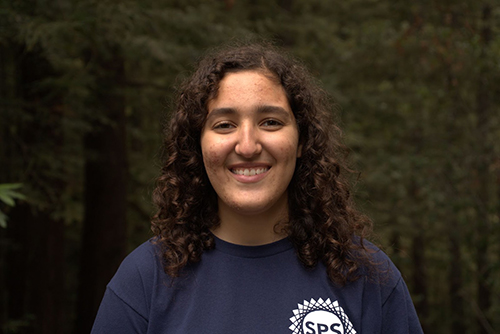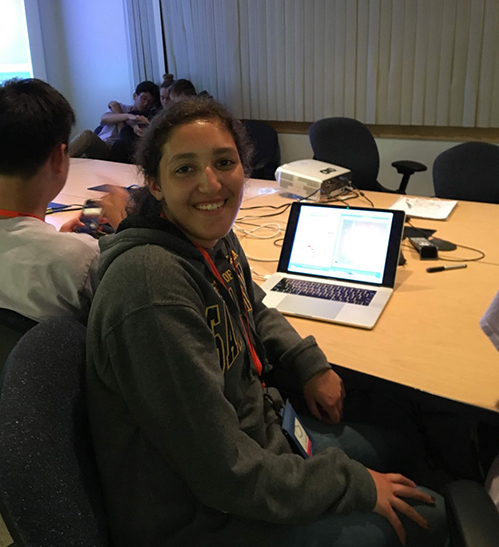Julia Stewart’s (Crown ’24, astronomy) passion for all things space-related began at an early age. She was an avid reader; her grandparents stocked her bookshelves with books about planets and the solar system. At her fifth-grade graduation, when it was her turn to announce her intention for what she’d like to become, she proudly proclaimed that she was going to be an astrophysicist.
In high school, Stewart excelled at math and science–passions further bolstered through her job at the Chabot Space & Science Center in which she demonstrated basic science principles through hands-on experiments with visitors. When she learned about the California State Summer School for Math and Science (COSMOS) in her junior year, she eagerly applied.
“I’ve been interested in astronomy from a young age, but no kid reading books can get a real sense of what the field is really like,” Stewart said. “COSMOS provided a more detailed picture of astrophysics, helped me get comfortable interacting with professors, and helped me hone skills that I continue to use today.
She was one of more than 200 high-achieving students in grades 8–12 from across the state who spent four weeks on the UC Santa Cruz campus learning advanced math concepts, participating in hands-on lab experiments, and engaging with current research led by UCSC faculty and graduate students.
Stewart had many firsts during her COSMOS experience. She was introduced to college-level calculus (multivariable derivatives) and physics concepts and she was thrilled to experience her first close-up view of the galaxies at night through the telescope at the Lick Observatory. She also explored the physics of sound and the astrophysics of light and studied rotation curves and dark matter content of galaxies as part of her COSMOS final project.
“There was a lot of advanced stuff that was new to me. I hadn’t taken calculus yet, and it was a big part of the course. I learned concepts as a high school junior that I didn’t come back to until my second year of college. But the faculty and grad students made it fun, and they were very supportive.”
“What stood out to me about Julia was that she was positively intense,” said professor and astronomer Puragra (Raja) GuhaThakurta, who serves as chair of the Department of Astronomy & Astrophysics. He led the astrophysics course for Julia’s cluster.
“She was motivated to learn and had an extraordinarily high level of engagement,” he said. “I was happy to see that she chose Santa Cruz.”
It was an easy choice for Stewart.
“I made my decision based on my COSMOS experience,” said Stewart a junior majoring in astrophysics. “I saw that the department was collaborative and supportive, and I knew it was a place in which I could thrive. It was an excellent decision.”
A highlight of her college experience was being selected to participate in a National Science Foundation Research for Undergraduate Experience (REU) in the summer of 2022. She spent several weeks in New York at the American Museum of Natural History where she expanded on research focused on interstellar hydrogen clouds in the Milky Way Galaxy. Her COSMOS experience came into play immediately.
“The very first day of the REU, I was working on a software system that I learned to use in COSMOS,” Stewart said.
While not all COSMOS students matriculate to UCSC, the quality of the experience and the opportunity to engage with world-renowned researchers gives students the confidence to pursue degrees in STEM fields.
“The purpose of the program is for us to identify students who are exceptionally motivated and also to enable students to see who we are as a university from a people aspect,” said GuhaThakurta. “When high school students apply to college, they apply to an institution. They rarely see the people of the university. The scientists they read about in textbooks are not the scientists of today. COSMOS gives them the chance to interact with today’s academics and to see the full range of diversity of those who are pushing the frontiers of knowledge.”
Stewart is excelling in her studies and has found her niche at UCSC. She attributes her success to the collaborative and supportive environment that originally attracted her to the department.
Recognizing that gender minority groups have long been underrepresented in STEM fields, Stewart is serving as an officer in the Society of Physics Students and participating in Women in Physics and Astrophysics, whose mission includes balancing and diversifying the community.
Inspired by her two experiences working in a museum setting, Stewart is considering the idea of sharing her work through science communication.
“Astrophysics is not simple; it can get technical very quickly,” she said. “I am intrigued by people who work in museums, write books, or use podcasts to communicate astrophysics to the general public. It’s a fun way for people to learn about a complex field.”
COSMOS was the portal through which Stewart found UCSC, where she is now paving the way for the next generation of math and science protégés who are looking for their own North Star.




